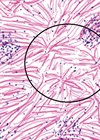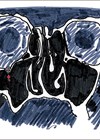This retrospective study was done to determine the prevalence of IgG4 related orbital disease (IgG4ROD) in patients who previously had biopsies for suspected idiopathic orbital inflammatory disease (IOID) and / or orbital lymphoproliferative disease (OLD). The charts and slides of 105 patients were reviewed. Slides were examined after staining for IgG4. Of them, 18 (17.15%) patients were found to fit the diagnostic criteria for possible IgG4ROD. The most common previous diagnosis for these patients was IOID, followed by benign reactive lymphoid hyperplasia. The most common presenting symptom was orbital / eyelid swelling (61%), followed by proptosis (50%) and ptosis (39%). The majority (89%) presented with unilateral disease. CT scan showed lacrimal gland enlargement commonly (39%), followed by extraocular muscle enlargement (28%). Patients with IgG4ROD have to be investigated for a systemic involvement and managed accordingly. The authors therefore suggest considering the above condition in the differential diagnosis of newly suspected and previously diagnosed cases of IOID and OLD.





